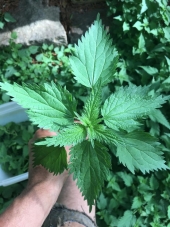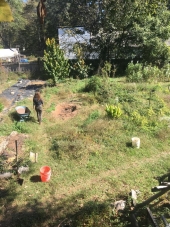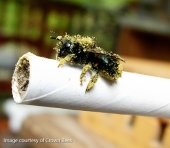First time doing this, probably not executed flawlessly, but it was an experience...
This was my oldest bee nesting box, I built and put it up maybe 4 or 5 years ago and have never done any maintenance on it. It is on the front of my house where we can watch it from the porch. In the past it was very active but this last year it was way less, so I knew it was time for some housekeeping. I should have gotten to it earlier in the winter but so it goes. I definitely saw the task as a bit daunting.
Brought the whole box in the house in the evening to sit and do this. Took quite a while to open all the tubes. All were natural materials, mostly small diameter bamboo/rivercane but also some elderberry that I pushed the pith out of and some other hollow plant stalks. The cane was the easiest to open, by inserting a knife a short way and then giving it a twist it would split down its length. The elder tubes would sometimes do this but many of them would flake off in pieces, same with the less woody stalks. Pretty tedious and time consuming. Lot's of stopping to take a closer look at all the weird stuff going on. I found healthy cocoons, old cocoons. wasp cocoons (dirt dobbers (?) used the larger diameter tubes) old pollen, lots of frass, lots of dirt, dead bees, dead worm/caterpillar things, unidentified shed exoskeletons, packed together dead spiders, and one small obvious pocket of pollen mites, and one live bee emerged. Some tubes were celled off with pine pitch. Years of all kinds of diverse critter activity. If an opened tube looked like it might have good cocoons it was emptied into a bowl with the hook tip of my knife or a chop stick. Once all the tubes were empty I called it quits for the night.
The next day I sifted everything and then rinsed them twice in tepid water which made a significant improvement. I didn't want to buy oxygen bleach just for this and found this page www.greenbeehoney.ca/bee-blog/fall-care-for-mason-bees gave directions for using peroxide to sanitize the cocoons and that is what I had on hand. I let them soak in the peroxide/water solution for several minutes as directed then rinsed again in running water. I let them drain for a while and then put them on paper towels to dry. At this point there were still a lot of old cocoons and other matter mixed in with the good cocoons. I experimented with winnowing this off and it seemed effective but I left them to dry fully first, and went to attend to other tasks. The weather had reached into the seventies and when I came back to the cocoons I could hear lots of chewing and see them jostling about. I sat and watched a good number of bees emerge, most flew off immediately while some would linger for a moment first. It was cool to see. Obviously since the bees are already ready to go I did not do any over winter storage or release protocol. I placed the screen with the remaining cocoons under roof cover but that is all.
For refreshing the nest box I blasted it off with the hose and then doused it with peroxide in a bin. I added enough water to submerge one side at a time and soaked each side in turn. I made new tubes from Korean giant celery and Japanese knotweed stalks and re-hung the nest. I hit the bricks with peroxide too.
All in all an interesting task...but not my favorite....











